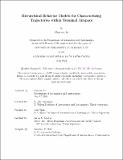| dc.contributor.advisor | Hansman, R. John | |
| dc.contributor.advisor | Shah, Julie | |
| dc.contributor.advisor | Kuchar, James K. | |
| dc.contributor.author | Li, Clement | |
| dc.date.accessioned | 2024-06-27T19:50:23Z | |
| dc.date.available | 2024-06-27T19:50:23Z | |
| dc.date.issued | 2024-05 | |
| dc.date.submitted | 2024-05-28T19:37:21.952Z | |
| dc.identifier.uri | https://hdl.handle.net/1721.1/155395 | |
| dc.description.abstract | Flight trajectories in terminal airspace, ranging from highly controlled airports to untowered airports, exhibit repeatable patterns. These patterns, or behaviors, may often contain sub-patterns, suggesting that the nature of aircraft behaviors in terminal airspace is hierarchical. While current methods for identifying patterns within historical ight track data use a at clustering approach, a hierarchical organization may be useful for better representing the multi-scale structure of trajectory patterns. At the same time, the features which distinguish between behaviors and sub-behaviors may vary across behaviors and at different levels in the hierarchy. This research proposes a hierarchical model of behaviors and develops a methodology which uses recursive clustering and feature selection for identifying a behavior tree within an airspace and applies the methodology to airspace at both general aviation and commercial airports. The hierarchical approach enables the identification of sub-behaviors with increased specificity, provides improved understandability of the clustering as a byproduct of dynamic feature selection, and also allows for a more nuanced concept of outliers. The identified behaviors are shown to reflect underlying structure present within the airspace without prior knowledge of that structure. Comparisons between different airports show that the behavior trees and underlying structure vary significantly between airports. The hierarchical behavior models are used in an example application of real-time behavior recognition and trajectory prediction. Additionally, an approach using hierarchical behavior models for identifying anomalous flights is presented. | |
| dc.publisher | Massachusetts Institute of Technology | |
| dc.rights | Attribution-NonCommercial-NoDerivatives 4.0 International (CC BY-NC-ND 4.0) | |
| dc.rights | Copyright retained by author(s) | |
| dc.rights.uri | https://creativecommons.org/licenses/by-nc-nd/4.0/ | |
| dc.title | Hierarchical Behavior Models for Characterizing Trajectories within Terminal Airspace | |
| dc.type | Thesis | |
| dc.description.degree | Ph.D. | |
| dc.contributor.department | Massachusetts Institute of Technology. Department of Aeronautics and Astronautics | |
| mit.thesis.degree | Doctoral | |
| thesis.degree.name | Doctor of Philosophy | |
